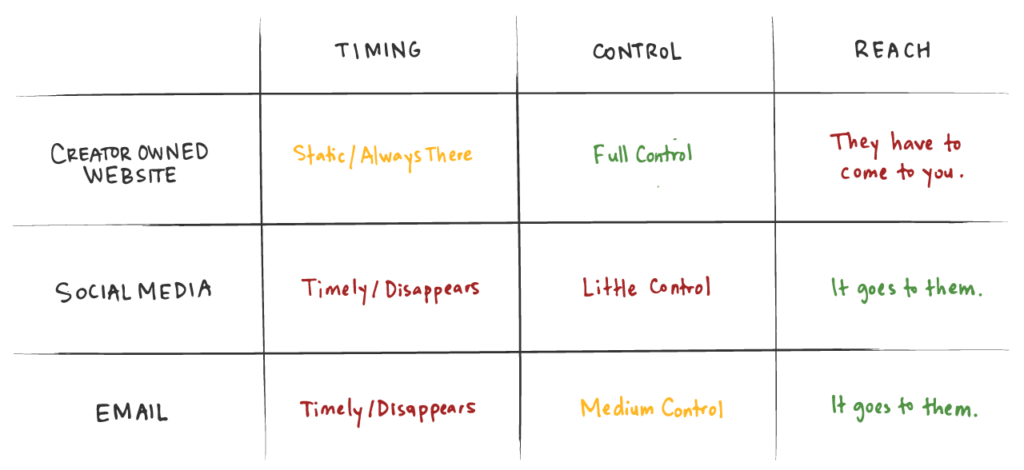
Channel Your Content
Find the Audience Value Mix for Your Content Across Platforms
Long Live the King
There is this overwhelming force in modern marketing to find the silver bullet platform.
“LinkedIn is the only place businesses post.”
“If you really want to talk to people, they are on Twitter.”
“Buy an email list like yesterday or the world will end.
“Myspace is where it’s at, bro.”
Okay, that last one hasn’t been said in over a decade. But some version of one of the sentences above has been confidently preached at you by a “marketing guru”. The tendency is to try and throw everything you have at one content platform because of that confident guru who just let you buy him coffee.
Well I’m sitting here at Kaldis and I bought my own coffee today. So I’m gonna tell you the truth.
There is no king when it comes to content.
This is a democracy, dangit.
The Value in Variety
Let’s start with your vital audience. Think about how they engage with content and marketing messages online. For the most part they are on one of the big four social platforms; Facebook, LinkedIn, Twitter, and Instagram. They probably are also engaging with content through an RSS reader (like News on their iPhone) or going directly to specific content platforms for news. They most definitely have two to five email inboxes that they check frequently throughout the day.
All of those channels have a different way that the audience connects with the content and different involvement from the platforms themselves. Social Platforms use algorithms to determine when content is visible to the audience (or if it is never visible). Email and RSS go into an app that the user controls and is usually sorted by the most recent content. Direct visits to websites require the audience to seek them out and the content is fully controlled by the owner of the site.
So why does this matter to you? Well, the variability, timeliness, and access the audience has to your content can both empower your message and also bury it like a search result on the third page of google (meaning it will never be seen).
Let’s Mix It Up!
The trick is in the mix; understanding the power of each channel and using it get your message to your vital audience. Let’s look at the balance of each channel across three factors; Timing, Control, and Reach.

TIMING
The best way to think of content timing is to think of it as either Timely or Static.
Timely means it’s made for today but over time will be less relevant. A great example is an event post. You want people to sign up for an event tomorrow so you post today. In three days, after the event is done that post won’t have a big value for you. An example of static content would be the About Us page on your website. You probably won’t build a time machine and change the history of your company anytime soon. Once you write this content and put it on your site it will remain static till you change it.
Assessing whether the core content is Timely or Static will help you understand the desired interaction from your audience and the best place for that core content to live.
NOTE: I’m using the term core content as a way of talking about the prime source of the content. If you write a blog post (like this one) it’s the core content. I’ll be posting links on social and probably sending this via email as well, that’s the secondary content I’m creating from the core.
CONTROL
I know most of you out there don’t want to admit it but you are in fact a control freak (even if you don’t know it yet). Depending on the channel you will either be able to fully control your core content or will be at the whims of the platform. Your website and to a somewhat lesser extent email are your playgrounds. You can design and shape your content virtually however you please. You can interconnect the content with other content, add functionality and cultivate an experience for your audience.
On social you are sort of stuck with the user experience you get, and this experience can change over time. This isn’t a bad thing as creative constraints are often what makes content great. But you are playing on someone else’s playground and you will live by their rules.
REACH
If we value audience as supreme then paying attention to how your content even gets to them is extremely important. I often ask members of the STORY cult, “If STORY is so important why don’t you go into your board room by yourself and tell it to the wall?” STORY is a valuable resource in your tool box but if you aren’t super serving your audience with content they need then you might as well say nothing at all.
How do you get out of your metaphorical boardroom and in front of your people? Reach describes the ways in which your audience gets to your content. On the social media platforms if the algorithm gods will it they see your posts in context with everything else they are looking at. On email they get it when you send right in their inbox with the accompanying notification. On your website, unless you post content to an RSS feed, they don’t see it till they go to your site. Now don’t forget, as your core content your site isn’t reaching your audience unless they show up. But when you create social posts or send it to your email list you can grab people where they are and bring them to your content.
Make It Matter
So how does each of the channels stack up?
CREATOR OWNED WEBSITE
This is your playing field, you get to create a unique user experience that you control. But, unlike in Field of Dreams, if you build it…they won’t necessarily come. You have to drive traffic to your site and make it easy for people to subscribe. Posting your content on other channels is a must and bringing people off the other platforms and into your domain is key.
SOCIAL MEDIA
They don’t call it social for nothing. Your people are already at the party, your goal is to try and show up in their feed. While you’re stuck with how you post and when (or if) your content will get to your people you can game the system a bit to get more reach. Make sure you are being “social” on social media. Don’t just post content but interact with your audience on their posts. Like, share, comment, repeat. Spend a small amount of time mingling at the party and it will pay dividends on your exposure.
Note: I’m mostly talking about organic reach in this post. You can scale up what I’m saying to paid traffic, but the ins and outs of buying reach is a topic for another post.
There is no school like the old school. Getting to your audience through email is as easy as having their address…and not hitting their spam filter…and timing it right so you get to them at a time they actually interact…and being relevant enough for them to read to your Call To Action. The trick with email is paying attention to the variables (when you send, subject lines and intro paragraphs) and finding what sticks with your list.
Don’t Hate the Playa
The bottom line is if you care about your audience (you should) then you want to reach them wherever they are. That means having a blend of channels that keeps you present and a strategy that keeps you from being annoying. Get started, start figuring out who you want to talk to, create some core content they will find valuable, then get out there and start getting that content to them on the right content platform.
Now go grow.
-TBR
More from Black Raven

Why Funnels Can Still Help You Build a Marketing Strategy
In business, popular concepts go in and out of fashion, but certain principles remain constant. To find a successful path for your business, you need

Rebrand with Confidence, Strategy, and Creativity
We understand that rebranding isn’t simply about changing logos or giving your business a modern look. It starts with a strategic process that requires thoughtful

Maximizing Social Media Impact: Balancing Planned and Organic Content
In crowded digital spaces, strategic social media management is essential for businesses looking to stay on top and get noticed. But what’s the best approach?